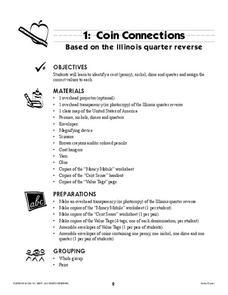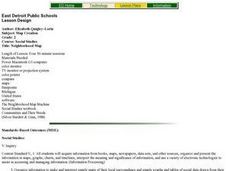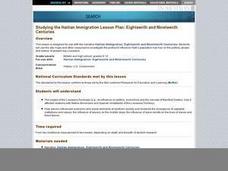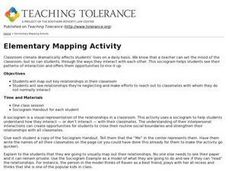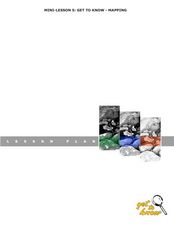Curated OER
Map Your State: Regions of Arizona
Fourth graders define vocabulary and locate physical features on maps. In this mapping lesson, 4th graders explore regions of Arizona through landforms found on topographic maps. Students research the history and culture of...
Curated OER
Plows on the Hunting Grounds
Students will examine and anaylze the assimilation of Native Americans in the US.
Curated OER
Coin Connections
A wonderful lesson on identifying the penny, nickel, dime, and quarter awaits your young mathematicians. They engage in a multi-session lesson which allows them to practice using the values of each coin in worksheets and activities...
Curated OER
Map Creation
Second graders identify a map, symbol, key, and compass rose. Students create and print a map for teacher evaluation using the computer. Students identify the symbols on their map and orally present them to the class.
Curated OER
Studying the Haitian Immigration: 18th and 19th centuries
Students read a narrative and conduct extensive research to determine how Haiti's population has had an influence on the social, political, and economic culture of present-day Louisiana. As a culminating activity, students write papers...
Curated OER
Matching the Globe with the Map
Students examine how to use a globe. In this globe and map comparison lesson, students discuss how the globe and map are alike when looking at Africa and Antarctica. Students investigate shapes and sizes of globes versus maps.
Curated OER
Mapping Africa
Students identify the location of parallel and meridian coordinates. They illustrate their understanding of the physical shape of the continent of Africa through a mapping activity, then explain the processes that have influenced the...
Curated OER
Generate an Accurate Landscape Profile from a Topographic Map
Students enerate an accurate landscape profile from a topographic map. They determine the correct interval needed to accurately graph the change in elevation on a single piece of graph paper.
Curated OER
MAPPING THE BLACK ATLANTIC
Learners examine the geographic characteristics of Western and Central Africa, the impact of geography on settlement patterns, cultural traits, and trade. They compare political, social, economic, and religious systems of...
Curated OER
SpellO': An Orienteering Lesson
Students participate in hands-on activities to practice orienting maps. Given activity cards, students accurately read maps and locate specific stations. Students collect information from the maps to spell a message when the activity...
Curated OER
Elementary Mapping Activity
Students build a classroom community. In this peer interaction lesson, students participate in a sociogram activity that requires them to socially interact with peers that normally they do not interact with. Students write about the...
Curated OER
United States Map- Rivers
Students learn about rivers. In this maps lesson, students describe rivers and what human activities take place in a river. Students use a map to locate the rivers in the United States.
Curated OER
CLASSROOM MAPS
Students do a blind tour of their school by responding to verbal commands. They look and discuss various maps in the classroom. They locate the direction of the sunrise and discuss the compass directions of North, South, East, and West.
Curated OER
Mapping the War
Students work in pairs to draw their own maps as specified of World War II areas. When all projects have been completed let one group at a time share their assignments with the rest of the class. Compile all the maps into a classroom...
Curated OER
Map Your Local Watershed!
Pupils study how to map their local watershed from a topographic map. They find the watershed on an aerial photograph and use maps and aerial photos from the Web to identify the human activity within the watershed, as well as various...
Curated OER
World Map and Globe- Introduction to Symbols
Students investigate picture symbols. In this symbols lesson plan, students define symbols and discuss symbols that they see in everyday life. Students identify symbols on maps by using post-it notes.
Curated OER
Mini - Lesson #5: Get To Know - Mapping
Students examine and draw landscape maps. In this mapping instructional activity, students investigate what a landscape map is. They draw a map showing objects on a small piece of natural landscape. Students fill in a grid sheet and a...
Curated OER
United States Map
Students compare the United States on a globe and on a map. In this map lesson, students relate the sizes of the continents and locate the United States. Students identify the location of the continental US as well as Alaska and Hawaii.
Curated OER
World Map and Globe - Lesson 15 (K-3)
Students discover mountain ranges and their locations in the world. In this physical map lesson, students locate and identify major mountain ranges of the world on a large physical map.
Curated OER
Putting It on the Map
Students consider the purpose of various types of maps and their different uses throughout history. They create their own maps and reflect on the map-making process.
Curated OER
Landscape Picture Map - Lesson 7 (K-3)
Pupils consider the changing landscape. In this map activity, students examine a large landscape picture map, discuss the building they find on it, and discuss how construction changes the landscape.
Curated OER
Manifest Destiny Lesson Plan
Learners examine how Americans justified Westward Expansion. In this American history lesson, your historians will watch a Manifest Destiny Powerpoint presentation and discuss each slide then participate in a class...
Curated OER
Mapping China
Learners identify cities in China on a map. In this map skills lesson, students locate the continent of Asia and the country of China. Learners use a blank map to label China and bordering countries.
Curated OER
Wagon's West: Life on the Trail
Students investigate what life on the Oregon Trail was like. In this Westward Movement lesson, students eat foods that were eaten by settlers on the trail as they read textbook pages about the trial. Students then draw an Oregon Trail...




